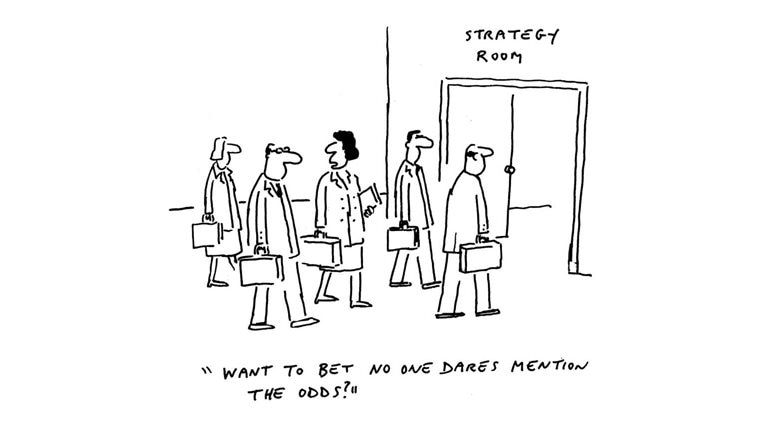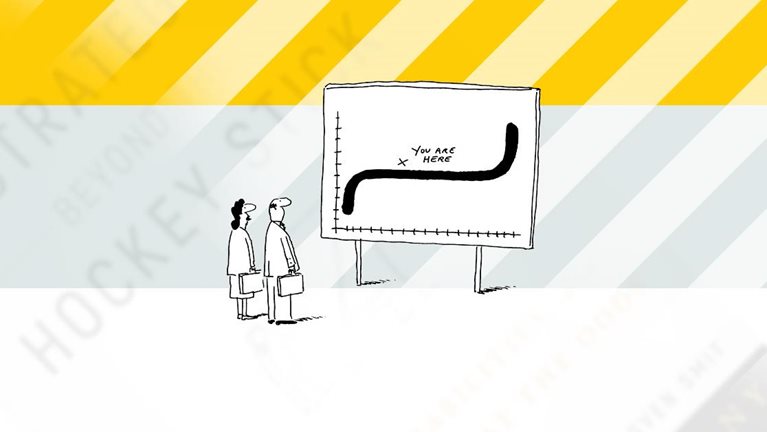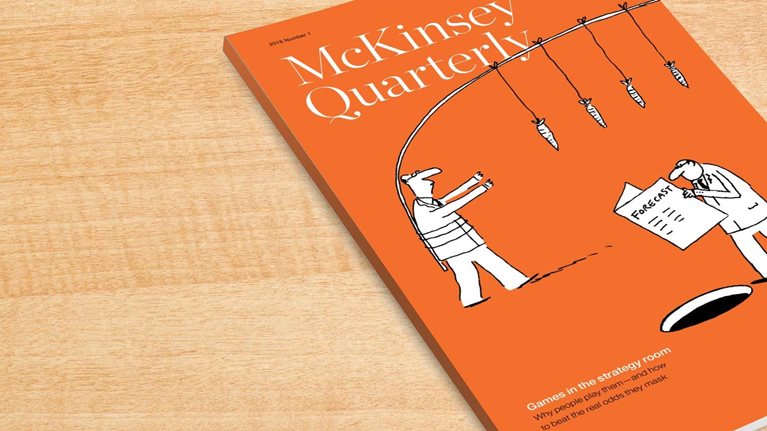“Predictions are difficult, especially about the future,” quipped Yogi Berra (and, before him, physicist Niels Bohr). This rings especially true for those trying to run a strategy process. Uncertainty is not only everywhere in and around strategy—it is the very reason we need strategy. Without uncertainty, we would just need a plan to go from A to B.
Stay current on your favorite topics
In running a business, there are many elements that you just can’t control—the fate of the economy, political events, your competitors’ actions. Yet uncertainty is rarely accounted for in a clear and robust way in the strategy room. Even proper planning for different eventualities is often missing from the discussion. Instead, we typically prepare for one version of the future, often without understanding how likely that version is to become reality.
Strategy requires confronting uncertainty head-on by embracing the notion of probability. In our new book, Strategy Beyond the Hockey Stick: People, Probabilities, and Big Moves to Beat the Odds (John Wiley & Sons, February 2018), we focus on the importance of calibrating the odds of a strategy succeeding, by building in explicit trigger points to reexamine decisions as we learn more and by applying the probabilistic approach to how we evaluate performance afterward. By understanding the chances your strategy has of succeeding before you start to execute it, and knowing how those odds change based on specific actions you take, you can tackle uncertainty with hard empirics, not guesswork or wishful thinking.
Why do we shy away from dealing with uncertainty? The root of the problem is our tendency to view strategy as a purely intellectual exercise—a sort of corporate game of chess, perhaps even played in three dimensions by its best practitioners. However, strategy poses the kind of low-frequency, high-uncertainty problems for which the human brain is least adapted. People are prone to many well-documented unconscious cognitive biases—overconfidence, anchoring, loss aversion, confirmation bias, and attribution errors, among others. These unintentional mental shortcuts exist to help us filter information for day-to-day decisions, but they can distort the outcomes when we are forced to make big, consequential choices, infrequently, and under high uncertainty—exactly what we confront in the strategy room.

Even the most seasoned executives have only limited experience and pattern recognition in these situations. They must make decisions based on limited information, and results may not show up for years. In the meantime, any number of factors—human, market, lag, and “noise”—can intrude and overwhelm any strategist’s ability to predict an outcome. Trying to improve your strategic decision making is like trying to improve your golf game by practicing blindfolded, and not finding out if your ball went into the hole for three years.
How we (fail to) deal with uncertainty
Spreadsheets aren’t built for odds and ranges. They are built for specific numbers, so it’s hard to deal with a 75 percent chance that a value will be between X and Y—multiplied by the thousands of cells in a corporate budget. US president Harry Truman famously said he wanted a one-handed economist so he would no longer have to hear his advisers saying, “On the one hand this, on the other hand that.”
Over our time working with hundreds of clients, we have seen many tactics that executives use to acknowledge the issue of uncertainty without really dealing with its implications. Here are some of our favorites:
We ignore uncertainty. Many strategy presentations start with an analyst-based projection of the market. Not a scenario, not a range of outcomes, but the “most likely version of the future.” And that’s the last thing you hear about uncertainty in the presentation. From then on, you get single-point estimates for the plan. “I can’t handle multiple realities,” one CEO told us. “I’d rather pick the world I live in.”
We treat uncertainty as an afterthought. The strategy room is a harsh place for most, and, quite frankly, failure on that stage is not an option for most managers. Execution problems? OK. A strategy that has gaps? We can fix that. But a strategy conversation about probabilities? You must be kidding! What you get instead is a slide about risk on page 149 of a 150-page deck, titled something like “Potential risk issues and how to mitigate them.” It’s there just so the presenter can say the issue is covered should the question about risk pop up.
We pretend to deal with uncertainty. In some cases, uncertainty is actually discussed in the strategy room. Say, geopolitical upheaval is threatening sales growth in an emerging market, or there are signs that a competitor may make an industry-consolidating move. A few scenarios may be presented, followed by a discussion about which of them is more or less likely to occur. Then one scenario is selected as the “base case,” and that’s probably the last thing you hear about uncertainty. Strategy clear, job done.
There are, of course, businesses that could not survive without dealing with uncertainty. For example, in asset management and other financial businesses, risk-weighted metrics are normal. The difference is that these professionals are moving money around. In more tangible businesses, you move around not just money but also people, along with the careers and reputations of business leaders. While the calculator loses reputation by wrongly calculating risk, the manager loses reputation by giving up resources.
Would you like to learn more about our Strategy & Corporate Finance Practice?
All these common practices and related errors can lay the foundation for setting the wrong ambition levels and, consequently, creating flawed strategies. There is nothing wrong with having bold targets, but those ambitions need to be anchored in the realities of the business and the evolving context in which it operates.
Understanding the reasons for outcomes
At some level, it is easy for the CEO to deal with uncertainty by playing the portfolio game of spreading investment like peanut butter around numerous businesses, knowing that not every bet has to pay off for the total plan to work. The problem is that a portfolio game on the corporate level becomes a matter of all-in commitment for an individual-business-unit leader. We have all heard the saying, “You are your numbers.” The saying isn’t, “Well, that project only had a 50 percent chance of success, so I won’t hold failure against you until you’ve had another similar failure or two.”
Assessing the reasons for a given outcome isn’t always easy. We may not be able to tell if a poor result was a noble failure, just as we can’t tell if the great result was blind luck. Was it a case of best efforts on a good bet that were foiled by a bad roll of the dice? Was it a more pernicious failure of planning or execution? Was it, perhaps, just a bad strategy to start with? Uncertainty doesn’t only mean we can’t see around the next corner; uncertainty also invades the past.
When deciding incentives, bonuses, and promotions, uncertainty and probabilities again come into play. Since we all want to succeed, most of us will vastly prefer a P90 plan (one that we will hit with a 90 percent chance) over a P50 plan (which we would hit only 50 percent of the times we try). In fact, many business leaders would quietly admit that they only agree to budget targets that they feel they can hit them almost for sure (P100), save any completely unexpected disruptions. Yet, when we ask CEOs what would be fair with respect to misses, many of them say that every three to four years a leader can be expected to miss a plan if the plan has been stretched enough—say, P60 to P75. This is a big difference in perspective.
Accounting for probabilities can make evaluating performance and outcomes uncomfortably complex, with key performance indicators much harder to specify. The situation resembles the FBI office that learns a gang intends to rob one of three banks. The head of the office dispatches teams to all three banks to catch the thieves. Obviously, only one team will capture the gang, but the entire unit should receive the praise and rewards. Yet we know that, most of the time, only those who are in the right place at the right time will be lauded as heroes.

From certainty to probability
To counter these predilections and help companies get a grip on uncertainty, we decided to bring empirical analysis to the assessment of probability in strategy. By examining dozens of variables for thousands of companies over more than a decade, we identified levers that explain more than 80 percent of the up-drift and down-drift in corporate performance. Using these benchmarks, CEOs and boards can dispassionately assess a strategy’s odds of success before signing off on it.
First, we plotted the economic profit of almost 2,400 companies on a graph. The resulting power curve shows that companies in the top quintile capture nearly 90 percent of the economic profit created—some 30 times as much as those in the middle three quintiles (exhibit).

We found that your industry’s performance is responsible for almost half of your position on the power curve. Industry impact is so substantial, in fact, that you would be better off as an average company in a great industry than a great company in an average industry. But here is the kicker: mobility on the curve is possible—but rare. The odds of a company moving from the middle quintiles to the top over a ten-year period are just 8 percent.
Additionally, we found that 10 variables explain nearly 90 percent of a company’s position on the power curve. They fall into three categories: endowment (what you start with), trends (the headwinds or tailwinds you face), and moves (five strategic actions you take). By benchmarking your company’s starting point, the trends it faces, and the moves you plan to make—against what our research shows is necessary to move the needle on the power curve—you can gain a precise probability score of your strategy succeeding. The results allow you to shift the conversation from single-point projections to probabilities.
Sometimes, even a simple calibration can stir a discussion on probability. One consumer-goods client set itself the target of achieving double-digit growth. The company did a great deal of planning, and the aspiration looked reasonable, but the client’s actual odds of success hadn’t entered the discussion. The plan was based on an inside view, built up from the combined estimates of each business unit.
A simple bit of research made the company reconsider. Publicly available information showed that, of industry peers within the same revenue range as our client, only 10 percent generated sustained double-digit growth over ten years. The question became: Is our strategy actually better than 90 percent of our peers? Really? What makes us stand out, even though we performed liked an average company over the prior five years, growing in the mid single digits? Bringing the actual odds into the strategy room made for a tough moment with the management team, but it did recalibrate the conversation in important ways.
Embracing this approach can be difficult for some teams. Companies in the top quintile tend to think that’s where they belong. After all, they worked hard to get there and have developed impressive advantages over the competition. Yet roughly 40 percent of companies at the top of the power curve will slide down over a decade, our research shows. Likewise, companies in the middle quintiles tend to believe that they can move up. Is there a chance that they will drop to the bottom quintile—why bother to even consider that possibility?

Strategy to beat the odds
So how do you create a strategy process that embraces probabilities? In any game, as in business, your goal must be to give yourself the best possible odds. If five companies each have an 80 percent chance of succeeding, that still means that one will usually fail. If five companies each have a 20 percent chance of success, one of the five is still likely to win. Clearly, the superior strategy is the one with an 80 percent chance of success, and this is the one that should be given the credit, no matter whether you win or lose.
Risk, of course, needs to be part of the probability discussion. With odds comes the explicit realization of risk, and loss aversion kicks in. Directly confronting risk can make people gun-shy, even when we want them to take more risk.
Assessing the risk is essential to deciding when they are worth taking and in pushing others to take them. If you have just a slim chance of winning, but a bet costs you little and the potential win is huge, that may still be an investment worth making. The converse is true, too. An expensive investment that generates a high probability of a small success may be a bad idea. Poker players refer to the calculations as “pot odds.” If a $100 bet gives you a 20 percent chance of winning a $200 pot, you fold. Essentially, you’re paying $100 for $40—that 20 percent of the $200. But a $100 bet that gives you a 20 percent chance of winning a $2,000 pot is one you make every time, because you’re paying $100 to get $400—20 percent of $2,000. So, an assessment of your odds—competitive, market, and regulatory, among others—needs to be part of your calculation.
It’s also essential to track assumptions over time. A few short weeks after the plan is developed, the detailed assumptions go into a fog of memory. The variance to budget gets tracked very carefully, but the underlying assumptions—such as uptake rates, market growth, or inflation rates—are not assessed as carefully. Rather, decide what you can today, with the information you have, and build explicit trigger points into the strategy to revisit decisions as new information surfaces.
We need to stop developing strategy as though we know the future. By calculating your chances of success, you can see if the plan you are asked to approve is based on a realistic aspiration or distorted wishful thinking. With an objective benchmark for calibrating your odds, you and your team will understand the strategy’s probability of success before you leave the room, much less before you begin to execute it.



